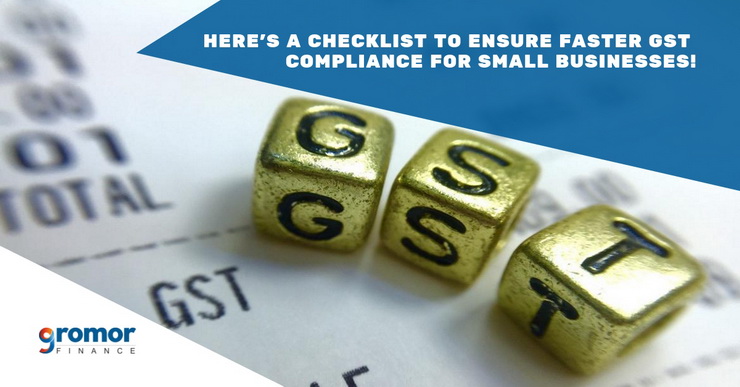Want to check the GST compliance of your small business? Here’s a checklist you could follow for faster GST compliance!
Follow These Steps For Faster GST Compliance!
GST compliance is just a few steps away!
1. Understand your business process in GST scenario and classify which transactions are goods and services…
These transactions will be most affected by GST. The Integrated Goods and Services Tax (IGST) model of taxation has been adopted for interstate transactions where Center would levy IGST which would be CGST plus SGST.
2. Classify your transactions under goods and services, and place of provisions…
After classifying the goods and services related transactions, recognize which provisions will be applicable to them. These provisions differ by location, industry and type of commodity.
3. Define the change in business in pre, during and post-manufacturing phases…
Reorganized manufacturing plants and warehouses would reduce the primary freight charges.
GST would eliminate the existing penalties on interstate sales transactions and facilitate the consolidation of vendors and suppliers.
Make a calculation of how your various functions are going to change and operate.
4. Understand your logistics model – depot and branches…
GST is a destination based tax, leading to a greater impact on logistics and the charges/taxes levied. You may have to strategize your supply management strategies in a manner that minimizes cash flow impact.
5. Define your sales policies – schemes, discounts and returns…
Should you charge GST to your customers for the items or services you provide? Would your pricing still be competitive? Defining your sales policies in compliance with GST will help you maintain your profit levels and customers.

6. Review your contracts – amendment to current POs…
Make sure that you make the required amendments to your current POs and contracts. It is advisable to define the terms and conditions to meet GST requirements.
7. Review your suppliers – nature of goods, place of supply, contractual terms
Contract terms, not only with your customers but also with your suppliers need to be revised. Make sure that you review your suppliers, what and where they supply and the mutual contracts.
In addition to this…
- Classify stock according to rate, purchase type (interstate or intrastate), duty paid or exempted.
- File the forms TRAN-1 and TRAN-2. This is an important process for claiming ITC (Input Tax Credit) on old stock.
- Collect Form-C, Form-H, and Form-I for the stocks on which ITC is to be claimed.
- Provide your GSTIN to all your suppliers and collect GSTIN from all customers.
- If registered as a centralized service provider, apply for migration to such states where your business may be operable.
- Make a list of rates under GST for all goods that you deal with.
- Make a list of all such on which reverse charge will be applicable.
- Ensure that all debit/credit notes are serially numbered.
- Check that your existing accounting software is integrated with your GST return filing software.
- Make sure that your invoicing solution is in line with the formats and rules for invoicing under GST. Also, be sure to check the invoicing series applicable to your product.
- Ensure that you are sending out a tax invoice for supplying taxable goods and services, and a bill of supply for exempted, nil-rated, and non-GST goods and services.
- Decide and prepare a list of Place of Supply for all your business activities.
Follow this quick checklist to ensure faster GST compliance!
For unsecured small business loans, get in touch with Gromor!


